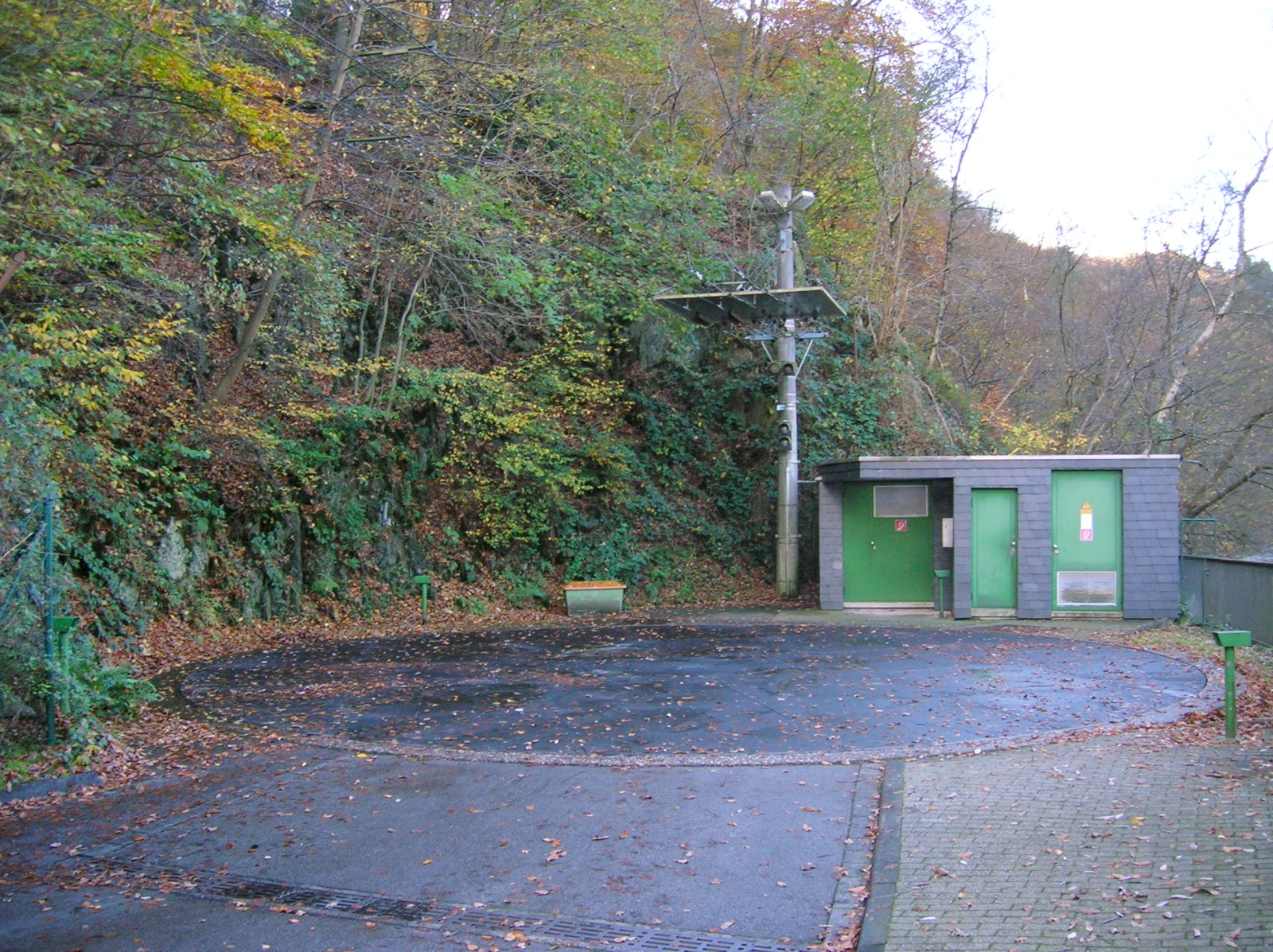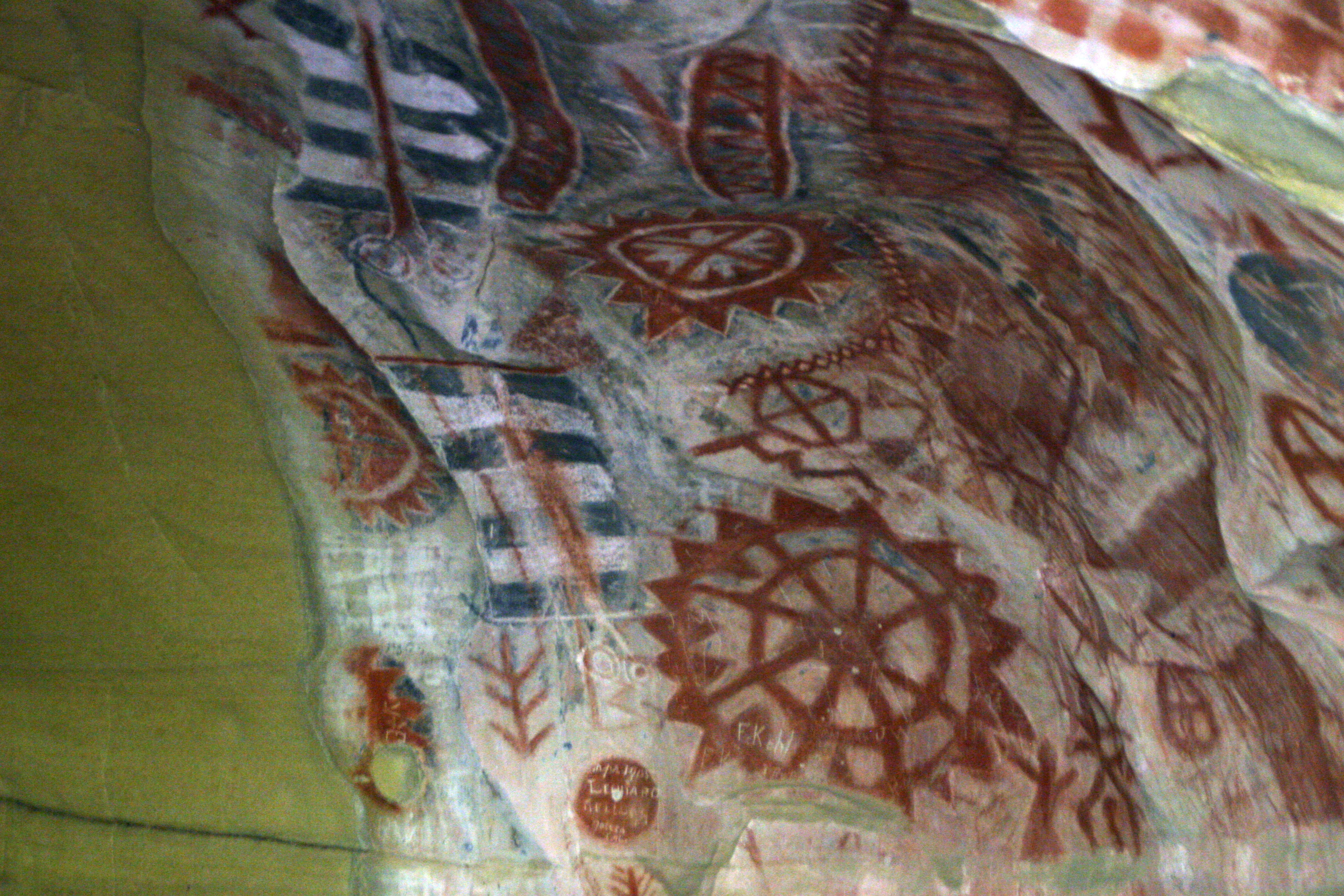|
Unterburg Trolleybus Turntable
The Unterburg trolleybus turntable () is a disused railway turntable, turntable for trolleybuses of the Trolleybuses in Solingen, Solingen trolleybus system, in the Solingen district Burg an der Wupper, Germany. The facility was regularly used by trolleybus line 683, operated by the Stadtwerke Solingen (SWS), until 15 November 2009, but is preserved in working condition. The turntable is the last of only four turntables of this type in the world. Two more were located in United Kingdom, Great Britain: the Christchurch trolleybus turntable (1936 to 1969) and the Longwood trolleybus turntable at Huddersfield (1939 to 1940). The fourth trolleybus turntable, in Guadalajara, Mexico, was in use from 1982 to 1983 and from 1985 to 1988. Description The turning process lasts 45 seconds and is always carried out without passengers on board. The turntable is remotely operated by the driver from an adjoining control house. The trolley poles are lowered manually before starting the rotatio ... [...More Info...] [...Related Items...] OR: [Wikipedia] [Google] [Baidu] |
Tram
A tram (also known as a streetcar or trolley in Canada and the United States) is an urban rail transit in which Rolling stock, vehicles, whether individual railcars or multiple-unit trains, run on tramway tracks on urban public streets; some include segments on segregated Right-of-way (property access), right-of-way. The tramlines or tram networks operated as public transport are called tramways or simply trams/streetcars. Because of their close similarities, trams are commonly included in the wider term ''light rail'', which also includes systems separated from other traffic. Tram vehicles are usually lighter and shorter than Main line (railway), main line and rapid transit trains. Most trams use electrical power, usually fed by a Pantograph (transport), pantograph sliding on an overhead line; older systems may use a trolley pole or a bow collector. In some cases, a contact shoe on a third rail is used. If necessary, they may have dual power systems—electricity in city stre ... [...More Info...] [...Related Items...] OR: [Wikipedia] [Google] [Baidu] |
Auxiliary Power Unit
An auxiliary power unit (APU) is a device on a vehicle that provides energy for functions other than propulsion. They are commonly found on large aircraft and naval ships as well as some large land vehicles. Aircraft APUs generally produce 115 V AC voltage at 400 Hz (rather than 50/60 Hz in mains supply), to run the electrical systems of the aircraft; others can produce 28 V DC voltage. APUs can provide power through single or three-phase systems. A jet fuel starter (JFS) is a similar device to an APU but directly linked to the main engine and started by an onboard compressed air bottle. Transport aircraft History During World War I, the British Coastal class blimps, one of several types of airship operated by the Royal Navy, carried a ABC auxiliary engine. These powered a generator for the craft's radio transmitter and, in an emergency, could power an auxiliary air blower. One of the first military fixed-wing aircraft to use an APU was the British, ... [...More Info...] [...Related Items...] OR: [Wikipedia] [Google] [Baidu] |
Carrosserie Hess
Carrosserie HESS AG is a bus, trolleybus and commercial vehicle manufacturer based in Bellach, Switzerland. Their products can be found operating in several countries, including the United States, Canada and Australia. History The company was founded in 1882, when Heinrich Hess set up business in Solothurn to build customised car bodies. The company first began building buses in 1919, and production reverted to aluminium products in 1933. It produced its first trolleybuses in 1940 for the Swiss cities of Basel and Biel/Bienne. In 1961, it commenced building of articulated vehicles, some of which were supplied to operators in the United States and Canada in 1975. The company soon began to expand, and businesses were set up in Portugal and Australia in 1957 and 1978 respectively. The U.S. business was set up in 1996. The company began production of low-floor buses and trolleybuses in 1991, and its first "Swisstrolley" model, built in conjunction with Nutzfahrzeuggesellschaft Arbon ... [...More Info...] [...Related Items...] OR: [Wikipedia] [Google] [Baidu] |
Rigid Bus
A bus (contracted from omnibus, with variants multibus, motorbus, autobus, etc.) is a motor vehicle that carries significantly more passengers than an average car or van, but fewer than the average rail transport. It is most commonly used in public transport, but is also in use for charter purposes, or through private ownership. Although the average bus carries between 30 and 100 passengers, some buses have a capacity of up to 300 passengers. The most common type is the single-deck rigid bus, with double-decker and articulated buses carrying larger loads, and midibuses and minibuses carrying smaller loads. Coaches are used for longer-distance services. Many types of buses, such as city transit buses and inter-city coaches, charge a fare. Other types, such as elementary or secondary school buses or shuttle buses within a post-secondary education campus, are free. In many jurisdictions, bus drivers require a special large vehicle licence above and beyond a regular drivin ... [...More Info...] [...Related Items...] OR: [Wikipedia] [Google] [Baidu] |
MAN SE
MAN SE (abbreviation of ''Maschinenfabrik Augsburg- Nürnberg'', ) was a manufacturing and engineering company based in Munich, Germany. Its primary output was commercial vehicles and diesel engines through its MAN Truck & Bus and MAN Latin America divisions, and participation in the manufacturer Sinotruk. MAN SE was majority-owned by Traton, the heavy commercial vehicle subsidiary of automaker Volkswagen AG, until August 2021 when Traton completed a squeeze-out of all remaining shareholders and formally merged MAN SE into Traton SE, meaning the former subsidiaries of MAN SE were now directly owned by Traton, and MAN SE ceased to exist. History Foundation MAN traces its origins back to 1758, when the "St. Antony" ironworks commenced operation in Oberhausen, as the first heavy-industry enterprise in the Ruhr region. In 1808, the three ironworks "St. Antony", "Gute Hoffnung" (English: "Good Hope"), and "Neue Essen" (English: "New Forges") merged, to form the Hütte ... [...More Info...] [...Related Items...] OR: [Wikipedia] [Google] [Baidu] |
Articulated Bus
An articulated bus, also referred to as a slinky bus, bendy bus, tandem bus, vestibule bus, stretch bus, or an accordion bus, is an articulated vehicle, typically a motor bus or trolleybus, used in public transportation. It is usually a single-decker, and comprises two or more rigid sections linked by a pivoting joint (articulation) enclosed by protective bellows inside and outside and a cover plate on the floor. This allows a longer legal length than rigid-bodied buses, and hence a higher passenger capacity (94–120), while still allowing the bus to maneuver adequately. Due to their high passenger capacity, articulated buses are often used as part of bus rapid transit schemes, and can include mechanical guidance system and electric bus or trolleybus. Articulated buses are typically long, in contrast to standard rigid buses at long. The common arrangement of an articulated bus is to have a forward section with two axles leading a rear section with a single axle, w ... [...More Info...] [...Related Items...] OR: [Wikipedia] [Google] [Baidu] |
Hand Crank
A crank is an arm attached at a right angle to a rotating shaft by which circular motion is imparted to or received from the shaft. When combined with a connecting rod, it can be used to convert circular motion into reciprocating motion, or vice versa. The arm may be a bent portion of the shaft, or a separate arm or disk attached to it. Attached to the end of the crank by a pivot is a rod, usually called a connecting rod (conrod). The term often refers to a human-powered crank which is used to manually turn an axle, as in a bicycle crankset or a brace and bit drill. In this case a person's arm or leg serves as the connecting rod, applying reciprocating force to the crank. There is usually a bar perpendicular to the other end of the arm, often with a freely rotatable handle or pedal attached. Examples Familiar examples include: Hand-powered cranks * Spinning wheel * Mechanical pencil sharpener * Fishing reel and other reels for cables, wires, ropes, etc. *Starting h ... [...More Info...] [...Related Items...] OR: [Wikipedia] [Google] [Baidu] |
Diameter
In geometry, a diameter of a circle is any straight line segment that passes through the centre of the circle and whose endpoints lie on the circle. It can also be defined as the longest Chord (geometry), chord of the circle. Both definitions are also valid for the diameter of a sphere. In more modern usage, the length d of a diameter is also called the diameter. In this sense one speaks of diameter rather than diameter (which refers to the line segment itself), because all diameters of a circle or sphere have the same length, this being twice the radius r. :d = 2r \qquad\text\qquad r = \frac. The word "diameter" is derived from (), "diameter of a circle", from (), "across, through" and (), "measure". It is often abbreviated \text, \text, d, or \varnothing. Constructions With straightedge and compass, a diameter of a given circle can be constructed as the perpendicular bisector of an arbitrary chord. Drawing two diameters in this way can be used to locate the center of ... [...More Info...] [...Related Items...] OR: [Wikipedia] [Google] [Baidu] |
Circle
A circle is a shape consisting of all point (geometry), points in a plane (mathematics), plane that are at a given distance from a given point, the Centre (geometry), centre. The distance between any point of the circle and the centre is called the radius. The length of a line segment connecting two points on the circle and passing through the centre is called the diameter. A circle bounds a region of the plane called a Disk (mathematics), disc. The circle has been known since before the beginning of recorded history. Natural circles are common, such as the full moon or a slice of round fruit. The circle is the basis for the wheel, which, with related inventions such as gears, makes much of modern machinery possible. In mathematics, the study of the circle has helped inspire the development of geometry, astronomy and calculus. Terminology * Annulus (mathematics), Annulus: a ring-shaped object, the region bounded by two concentric circles. * Circular arc, Arc: any Connected ... [...More Info...] [...Related Items...] OR: [Wikipedia] [Google] [Baidu] |
Balloon Loop
A balloon loop, turning loop, or reversing loop ( North American Terminology) allows a rail vehicle or train to reverse direction without having to shunt or stop. Balloon loops can be useful for passenger trains and unit freight trains. Balloon loops are common on tram and streetcar systems. Many streetcar and tram systems use single-ended vehicles that have doors on only one side and controls at only one end. These systems may also haul trailers with no controls in the rear car, and, as such, must be turned at each end of the route. History Balloon loops were first introduced on tram and, later, metro lines. They did not commonly appear on freight railways until the 1960s, when the modernising British Rail system introduced '' merry-go-round'' (MGR) coal trains that operated from mines to power stations and back again without shunting. Tramways On the former Sydney tram system, loops were used from 1881 until the second-generation system's closure in 1961. Initial ... [...More Info...] [...Related Items...] OR: [Wikipedia] [Google] [Baidu] |








